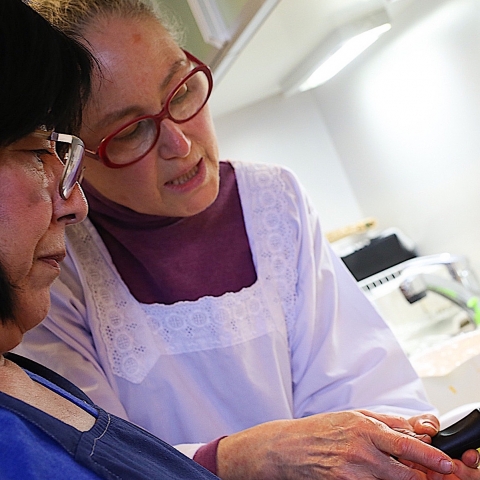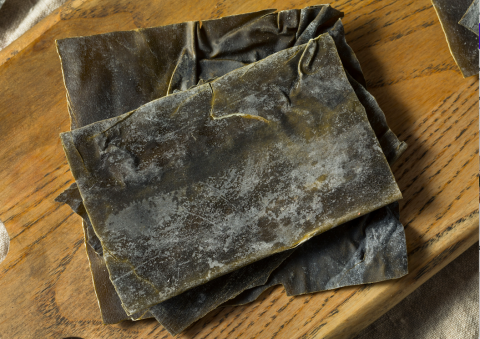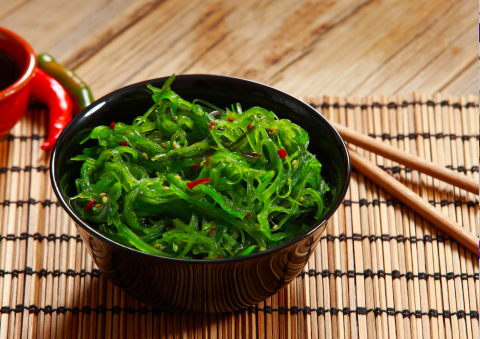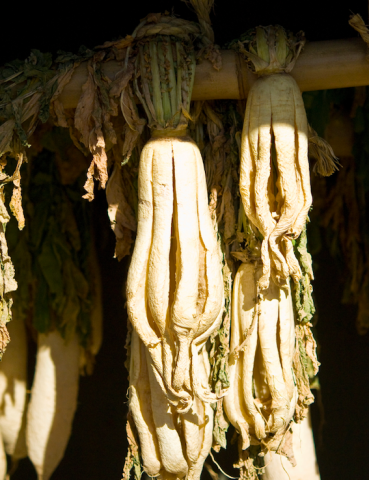Why Kambutsu Should Be Your Kitchen’s Secret Weapon
Kambutsu by definition is simply "dried things." Shriveled and sold in sealed packages, there’s nothing particularly attractive about them, but HRN host Akiko Katayama and Elizabeth Andoh want to make it clear that they are secret weapons in the kitchen. In contrast to the natural sweetness of a dried tomato or apricot intensified by the drying process, Japanese kambutsu concentrate umami flavor, offering convenience and tremendous versatility in recipes.

Akiko welcomed Elizabeth Andoh, an all-star Japan Eats! guest, back to the show for her 11th interview to talk about kambutsu. Elizabeth is a food writer, the author of six cookbooks, and a Japanese cooking instructor based in Tokyo. Kambutsu is one of her favorite Japanese foods and is her “go-to” for dinner when she hasn’t had a chance to go shopping.
Many people may be missing out on the convenience and wonders kambutsu offer.
While kambutsu has always been popular among chefs at a wholesale level, their use in home kitchens has declined. Most large supermarkets have some kambutsu basics, but when Elizabeth first arrived in Japan in the 1960s there were specialty stores in every neighborhood dedicated to kambutsu. They have since nearly disappeared. Without cooking shows or Instagram accounts giving these foods some love, many new cooks may not know how to use them. In addition to not having an eye-catching appearance, Elizabeth admits the instructions on the back of their packages are not always immediately understandable, despite being very simple to use.

Akiko feels that kambutsu reflects the Japanese mindset to preserve everything, emphasizing that Japan is a small country that was very poor until recent centuries. The first written record of kambutsu was in the Man'yōshū, a poetry collection from about 760 CE, although kambutsu were probably consumed as far back as 14,000 BCE in the Jomon period. Developing kambutsu probably occurred naturally: people found out that as food dried out, flavors would intensify and spoilage slowed. In the days before refrigeration or swift transportation, kambutsu became a way to ensure a year-round food supply. Dehydrating food also decreased its weight, making it easy to carry.
Whether from land or sea, an animal product or a vegetable, there's a place for kambutsu in every kitchen.
Given their wide range of applications in the kitchen, Elizabeth and Akiko are both eager for a flashy rebrand that gives kambutsu the spotlight it deserves. They’re here to break down some of their favorite kambutsu, how to use kambutsu, and what recipes you can use kambutsu in. Once you've decided on your kambutsu of choice, storing it before use is easy. All you need is a cool, dry, dark space. If your kitchen doesn’t have an extra drawer to spare, it can really be kept anywhere as long as it meets these conditions.
Kanso wakame

This sea vegetable is harvested and then briefly boiled, giving it a bright green color. It expands three times in size when rehydrated, so a little goes a long way. Elizabeth typically uses wakame in soups and salad recipes, and it's the star of Akiko's summer salad. In the summer it’s delightful with mustard, vinegar, and miso. In the winter, a darker red miso with sugar can make a great dip for wakame. In soups, Elizabeth recommends putting it at the bottom of the bowl and pouring the soup on top so the wakame doesn’t get overcooked. It’s great in miso soup and noodle dishes, and adding some to any dish easily deepens the flavor.
Hijiki
Another sea vegetable, hijiki is harvested in long fronds. You can buy it as me-hijiki (small bud pieces) or naya-hijiki (longer strands). Both styles can be cooked and used exactly the same way. This is a classic at a Japanese Izakaya, served with fried tofu and a mixture of sweet and soy sauce. Elizabeth likes to match the style of hijiki with the rest of the meal. If she’s serving it in a small bento, she uses me-hijiki and cuts the carrots and tofu into small pieces to accompany it. If she wants a dish with more volume, Elizabeth uses naya-hijiki and juliennes her carrots. Hijiki will keep for 2-3 days, so Elizabeth likes to make a lot and use the rest in a tofu sauce.
Kampyo
Kampyo is a gourd that is shaved into ribbons. You can find kampyo rolls at traditional sushi restaurants, sweet and crunchy, with a great mouth feel, and packed with umami flavor. To prepare for a sushi roll, kampyo is softened, then simmered in a slightly sweet soy broth. It can be made into an addictive dried chip and makes a lovely broth.

Kiriboshi daikon
These daikon radishes are often dried in shreds. Kiriboshi daikon is a kambutsu that can multitask: it makes a flavorful broth when rehydrated and can be cooked as a vegetable on its own or mixed with other ingredients. It's a classic with carrots and fried tofu. Kiriboshi daikon is also delicious when softened and cooked with a piece of kombu. Shredded and served with bacon or chicken it makes a great main course.
Kanten
Kanten is a sea vegetable most often used for its ability to set like gelatin. It sets more firmly at room temperature and can also gel with fruits like pineapple, which gelatin cannot. Kanten sold in sticks or as a powder. Elizabeth recommends kanten powder for the easiest use. It can create delicious chewy snacks and confections which are often found in tea ceremonies. One of Elizabeth's favorites is dried persimmons and kanten.
Making Stock
Kambutsu can be used for stocks or cooked into dishes; although sometimes one food item can be used both ways. For stock, kombu can be simmered in water to extract the flavor. Dried fish is also great for stock; Elizabeth calls katsuobushi the “bacon of the sea” because of its smoky flavor. Dried shiitake mushrooms, kiriboshi daikon, or kampyo also make delicious vegetarian stocks (and check out our article all about dashi stock).
How to Rehydrate Kambutsu
 Kambutsu needs to be rehydrated in order to be used in cooking. Hydration times vary and sometimes the soaking liquid can be consumed, other times it cannot. A key indicator is whether the packaging says the food has been chemically dried or bleached. While these methods render kambutsu that is fine to eat, Elizabeth does not recommend ingesting the soaking liquid. If kambutsu has been naturally dried, however, the soaking liquid can be used for cooking.
Kambutsu needs to be rehydrated in order to be used in cooking. Hydration times vary and sometimes the soaking liquid can be consumed, other times it cannot. A key indicator is whether the packaging says the food has been chemically dried or bleached. While these methods render kambutsu that is fine to eat, Elizabeth does not recommend ingesting the soaking liquid. If kambutsu has been naturally dried, however, the soaking liquid can be used for cooking.
When properly rehydrated, kambutsu doesn’t go back to its original state, it becomes more flavorful. While a lot of kambutsu is meant for daily meals, there are products like dried abalone, which is not only an expensive export but also used for ceremonial purposes.
Elizabeth likes to use glass jars to rehydrate kambutsu because they are non-reactive and will not impact the flavor. If the soaking water will not be used in a recipe, use only enough water to soak the kambutsu. Most kambutsu will be softened within 5-10 minutes but can soak for long periods, which makes it convenient to prepare ahead. If you want to prep your food the night before or in the morning, you’ll have the start of a stock waiting for you when you're ready to cook. If your kitchen is very warm, just pop the kambutsu and water in the fridge while it soaks. Elizabeth advises against soaking wakame and hijiki for long periods of time. These kambutsu should be soaked for no more than 5-6 minutes then drained, rinsed, and drained again.
When your new recipes are ready to serve, Korin has the perfect tableware. While rooted in Japanese culture and traditions, their incredible collection of knives, tableware, glassware and more are not only for Japanese kitchens. They can be used for any cuisine - whether cooking professionally or cheffing it up at home. Korin is dedicated to this ideal: bringing the simplicity and elegance of Japanese culture to your table. Thanks to Korin for supporting HRN and making this article and episode of Japan Eats! possible.
Listen to this episode of Japan Eats! here or find the show wherever you listen to podcasts:










